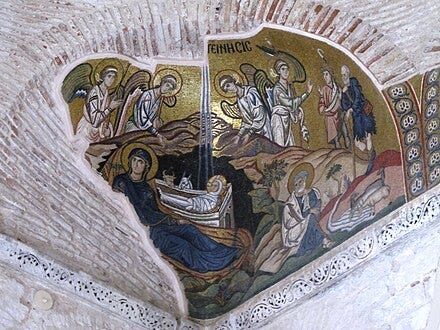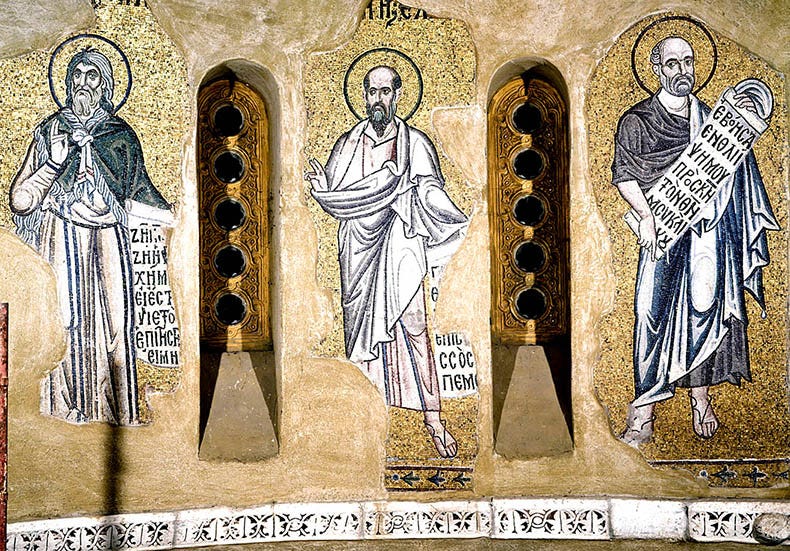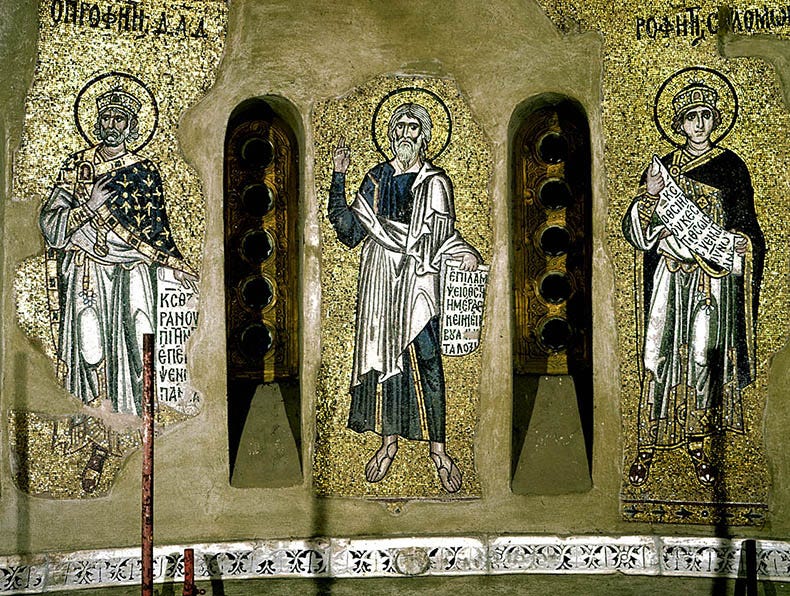
Constructed during the 11th century, Daphni Monastery represents one of the pinnacles of Byzantine religious art and architecture. Although its mosaics are widely recognized, the monastery’s frescoes offer a complementary narrative about the devotional practices and artistic innovations of the era. These wall paintings, executed with a deep sensitivity to spiritual symbolism and technical refinement, illustrate the integration of classical artistic traditions with emerging Byzantine aesthetics. Serving both didactic and liturgical functions, the frescoes articulate complex theological ideas for an audience largely unfamiliar with written doctrine. Their vibrant colors, dynamic compositions, and meticulous execution stand as a testament to the technical skill and spiritual vision of their creators (UNESCO; Mango; Krautheimer).
Daphni Monastery was founded in a period marked by significant socio-political and cultural transformations within the Byzantine Empire. The 11th century witnessed both the consolidation of imperial power and an intensification of religious expression. Monasteries, including Daphni, evolved into centers of theological debate, artistic innovation, and community cohesion. During this era, the Byzantine state encouraged the patronage of religious art as a means of reinforcing orthodoxy and imperial ideology. The frescoes at Daphni reflect this dual purpose: they are both expressions of personal piety and instruments of state-supported religious education (Mango; The Oxford Dictionary of Byzantium). Moreover, local monastic initiatives, coupled with imperial patronage, fostered an environment in which artistic experimentation flourished, leading to new developments in composition, use of color, and spatial organization.
Beyond its immediate religious function, Daphni Monastery became a symbol of regional identity and cultural resilience. As local communities experienced economic and political pressures, the monastery, and its art, offered a form of continuity and hope, embodying the Byzantine ideal of a society rooted in divine order and historical memory (Haldon). This period also saw the exchange of ideas between Byzantium and the wider Mediterranean world, a factor that influenced both the iconography and technique of the frescoes.
The mosaics at Daphni Monastery adorn several critical interior spaces and serve as visual sermons that articulate key Byzantine doctrines. Prominent among these is the depiction of Christ Pantocrator, whose stern, majestic visage embodies the Byzantine ideal of divine authority and omnipotence. This image, often centrally located, anchors the space both spiritually and artistically. Adjacent panels feature the Theotokos (Virgin Mary) and various saints, each rendered with a dignified frontal presentation that emphasizes their sanctity and role as intercessors. Narrative scenes from the Bible and the lives of saints further enrich the iconographic program, inviting contemplation and reinforcing doctrinal messages (Beckwith; Cormack).
The frescoes and mosaics exhibit a sophisticated integration of symbolism and form. For example, the use of a muted palette interspersed with vibrant highlights suggests a deliberate play with light to evoke spiritual luminescence. Geometric and floral motifs often serve as borders, reinforcing the theological idea of order amidst the chaos of the material world. Scholars have noted that the spatial organization within these frescoes, a combination of hierarchical composition and a subtle use of perspective, indicates an evolving approach to conveying narrative depth and emotional resonance (Krautheimer). Such techniques not only enhance the visual impact of the frescoes but also serve to educate the faithful about the celestial order and the divine plan.
Technically, the frescoes of Daphni Monastery are exemplary of 11th‑century Byzantine painting methods. The artists employed a multilayered approach, beginning with a carefully prepared plaster surface followed by an underdrawing executed in charcoal. Egg tempera, mixed with natural pigments, was then applied to create the vivid, enduring images. This method allowed for a high degree of detail and subtle tonal variations, which were essential for conveying both the physical presence and the transcendent qualities of the subjects. Recent conservation studies by the Hellenic Ministry of Culture have underscored the meticulous preparation of the surfaces and the innovative techniques that have allowed these frescoes to endure environmental challenges over the centuries (Hellenic Ministry of Culture).
Stylistically, the frescoes represent a transitional phase in Byzantine art. They mark a departure from the static, formulaic representations of earlier periods, embracing instead a more dynamic and expressive mode of representation. This shift is visible in the refined rendering of drapery, the emotive expressions of the figures, and the nuanced treatment of spatial depth. The incorporation of classical motifs alongside emerging Byzantine aesthetics reflects a broader cultural synthesis, as artists drew upon the heritage of antiquity while simultaneously forging a distinctively Christian visual language (Cormack; The Oxford Dictionary of Byzantium). This synthesis of old and new is central to understanding the evolution of Byzantine art during the 11th century.
The frescoes at Daphni Monastery have sparked extensive scholarly debate regarding their stylistic evolution, iconographic innovations, and theological significance. One key point of discussion centers on the extent to which these frescoes represent a transitional phase in Byzantine art. Some scholars argue that the works at Daphni illustrate a move toward increased naturalism and emotional expression, a precursor to the later developments in Byzantine painting. Others maintain that the frescoes remain firmly rooted in traditional iconographic models, with any apparent dynamism serving to enhance rather than redefine established conventions (Beckwith; Haldon).
Additional debates concern the role of the monastic workshop in the production of these frescoes. While the identities of individual artists remain unknown, stylistic analysis suggests the presence of an organized workshop that adhered to rigorous iconographic standards while also experimenting with new artistic techniques. This collaborative model highlights the dual function of monastic art as both a devotional practice and an educational tool. The frescoes thus not only served to embellish sacred spaces but also acted as visual curricula for the monastic community and the laity (The Oxford Dictionary of Byzantium).
The conservation of Daphni’s frescoes is a subject of ongoing research and international collaboration. Environmental degradation, humidity, and prior restoration attempts have all contributed to the challenges of preserving these priceless works. Modern conservation efforts, guided by principles of minimal intervention and historical authenticity, are informed by interdisciplinary research combining art history, chemistry, and materials science. Recent projects have utilized non-invasive imaging techniques and pigment analysis to better understand the original materials and methods employed by the artists (Hellenic Ministry of Culture; Krautheimer).
The modern relevance of these frescoes extends well beyond their aesthetic and historical value. In today’s globalized world, where questions of cultural heritage and preservation are increasingly prominent, Daphni Monastery serves as a vital link to Byzantine history and identity. The frescoes inspire contemporary debates about the role of art in public life and the ethical imperatives of conservation. They remind modern audiences of the enduring power of sacred art to communicate complex spiritual truths and foster a shared sense of cultural memory (UNESCO; Cormack). Additionally, the conservation techniques developed for Daphni are being applied to similar heritage sites, ensuring that the lessons of Byzantine art continue to inform future preservation practices.
The 11th‑century frescoes of Daphni Monastery stand as masterpieces of Byzantine art, encapsulating the era’s spiritual fervor, technical innovation, and cultural synthesis. Through their intricate iconography, refined techniques, and evocative style, these frescoes offer profound insights into the theological and artistic priorities of Byzantine society. As both objects of scholarly inquiry and targets of modern conservation efforts, they continue to challenge and inspire discussions about the nature of sacred art and the preservation of cultural heritage. In Daphni, the luminous interplay of color, light, and form not only illustrates a pivotal moment in art history but also endures as a living testament to the transformative power of artistic expression.
References:
Beckwith, John. Byzantine Art. Harvard University Press, 2009.
Cormack, Robin. Byzantine Art. Oxford University Press, 2000.
Haldon, John. The Byzantine World. Harvard University Press, 2002.
Hellenic Ministry of Culture and Sports. Daphni Monastery. Hellenic Ministry of Culture and Sports, www.culture.gov.gr/en/service/SitePages/view.aspx?iID=65. Accessed 10 Jan. 2025.
Krautheimer, Richard. Early Christian and Byzantine Architecture. Penguin Books, 1986.
Mango, Cyril. Byzantine Architecture. University of Toronto Press, 1981.
Mango, Cyril, editor. The Oxford History of Byzantium. Oxford University Press, 2002.
The Oxford Dictionary of Byzantium. Edited by Alexander Kazhdan, Oxford University Press, 1991.
UNESCO World Heritage Centre. Daphni Monastery. UNESCO, https://whc.unesco.org/en/list/537/. Accessed 10 Jan. 2025.









The most impressive thing to think about for me is the egg tempera. Like how many eggs we talking here? Were there that many chickens laying per day? The logistics of this is mind blowing. Also, I wonder where the gold for the leafing was coming from. Then comes all the resin or rabbit skin glue… it seems to me everyone in the region would be some form of supplier, worker or transporter for the sheer volume this project required. Which makes me think the artists themselves were very well known. It’s just history that has lost them!
Looks like it may have inspired the abandoned monastery in BG3